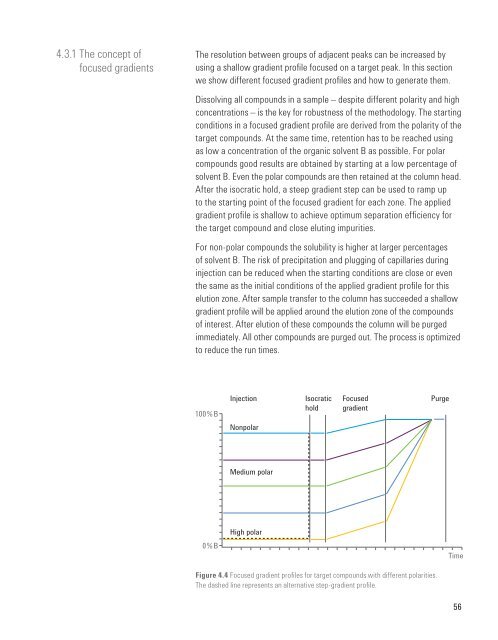Principles and Practical Aspects of Preparative Liquid Chromatography
You also want an ePaper? Increase the reach of your titles
YUMPU automatically turns print PDFs into web optimized ePapers that Google loves.
4.3.1 The concept <strong>of</strong><br />
focused gradients<br />
The resolution between groups <strong>of</strong> adjacent peaks can be increased by<br />
using a shallow gradient pr<strong>of</strong>ile focused on a target peak. In this section<br />
we show different focused gradient pr<strong>of</strong>iles <strong>and</strong> how to generate them.<br />
Dissolving all compounds in a sample – despite different polarity <strong>and</strong> high<br />
concentrations – is the key for robustness <strong>of</strong> the methodology. The starting<br />
conditions in a focused gradient pr<strong>of</strong>ile are derived from the polarity <strong>of</strong> the<br />
target compounds. At the same time, retention has to be reached using<br />
as low a concentration <strong>of</strong> the organic solvent B as possible. For polar<br />
compounds good results are obtained by starting at a low percentage <strong>of</strong><br />
solvent B. Even the polar compounds are then retained at the column head.<br />
After the isocratic hold, a steep gradient step can be used to ramp up<br />
to the starting point <strong>of</strong> the focused gradient for each zone. The applied<br />
gradient pr<strong>of</strong>ile is shallow to achieve optimum separation efficiency for<br />
the target compound <strong>and</strong> close eluting impurities.<br />
For non-polar compounds the solubility is higher at larger percentages<br />
<strong>of</strong> solvent B. The risk <strong>of</strong> precipitation <strong>and</strong> plugging <strong>of</strong> capillaries during<br />
injection can be reduced when the starting conditions are close or even<br />
the same as the initial conditions <strong>of</strong> the applied gradient pr<strong>of</strong>ile for this<br />
elution zone. After sample transfer to the column has succeeded a shallow<br />
gradient pr<strong>of</strong>ile will be applied around the elution zone <strong>of</strong> the compounds<br />
<strong>of</strong> interest. After elution <strong>of</strong> these compounds the column will be purged<br />
immediately. All other compounds are purged out. The process is optimized<br />
to reduce the run times.<br />
100%B<br />
Injection<br />
Isocratic<br />
hold<br />
Focused<br />
gradient<br />
Purge<br />
Nonpolar<br />
Medium polar<br />
High polar<br />
0%B<br />
Time<br />
Figure 4.4 Focused gradient pr<strong>of</strong>iles for target compounds with different polarities.<br />
The dashed line represents an alternative step-gradient pr<strong>of</strong>ile.<br />
56



